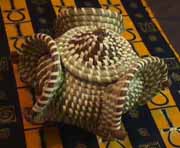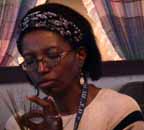Making Sweetgrass Baskets
at the
Bennett's Pentacostal Church in Awendaw
Sweetgrass baskets are the most traditional of the Gullah crafts, and are directly connected to the cultivation of rice. Sennagambian rice cultivators brought these skills to the low country of South Carolina in the late seventeenth century. Today, their descendents maintain the tradition in and around Charleston. The Bennett family continues to practice these skills along Highway 17. The Cleveland Great Migration Workshop had the good fortune to receive instruction in the art of sweetgrass basket making
Jim Heffernan, teacher of English literature at Rhodes High School in Cleveland, Ohio, toiled with such great success at the basket weaving workshop that he earned the nickname, "Sweetgrass Jim."
Among the first steps in making a sweetgrass basket is evening off a handful of grass. Marlana Hamer, also of Rhodes High School, is intensely concentrating on this deceptively difficult task.
After the initial wrapping of sweetgrass with narrow
strips of palm leaf, the weaver uses a pointed tool, often fashioned from a spoon handle, to guide the strands of palm through the tightly wrapped sweetgrass.Here, Pam Craig, a middle school teacher in Cleveland Municipal School, sews the coils of her basket with the help of her tool. Traditionally, sweetgrass basket tools were fashioned from bones sharpened on glass edges.
Beverly Lloyd, Media and Curriculum Specialist for Cleveland Municipal Schools, observed:
"When you watch the Gullah women of
Charleston make sweetgrass baskets, it takes you back hundreds of years to the villages of West Africa. Attending a basket-making session helped us develop a new appreciation for this ancient artistic skill. Learning to manipulate the sweet grass while sewing with a palm reed was quite a challenge. We wondered if we would ever complete a semblance of the beautiful baskets that the Gullah women take only a few hours to create."

